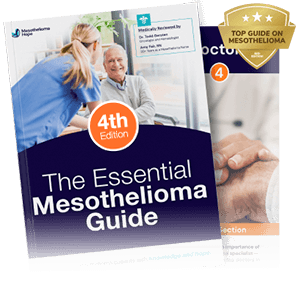What Is Asbestos Lung Cancer?
Lung cancer cases drastically outnumber mesothelioma diagnoses by 73 to 1. In 2022, the American Cancer Society estimated that nearly 240,000 people would be newly diagnosed with lung cancer yearly.
About 80% of lung cancer tumors result from carcinogens, such as:
- Tobacco smoke
- Heavy metals
- Various pollutants
Asbestos exposure is directly responsible for 20% of lung cancer tumors.
Mesothelioma is a much rarer disease, with an average of 3,000 cases yearly.

The only known cause of mesothelioma is asbestos, particularly by airborne asbestos fibers entering the lungs and traveling to the mesothelium (the protective membrane covering the abdomen, heart, lungs, and testes). Asbestos fibers become trapped in the mesothelium and begin to damage surrounding areas.
Additionally, asbestos exposure is the only known cause of mesothelioma, and the chances of successful treatment for this type of cancer are low. Lung cancer tumors, however, can be isolated and treated because of the way they are structured.
Order our Free Mesothelioma Guide to learn how we can help you after you receive a diagnosis of asbestos-related lung cancer or pleural mesothelioma.
Lung Cancer Versus Mesothelioma
There is a distinct difference between lung cancer and mesothelioma. Tumors in lung cancer tissue are far more common than tumors in the mesothelium.
Medical specialists are not sure what causes cells to turn cancerous. Healthy human cells live and die at a predictable and controllable rate. New cells form and divide to replace old cells, and that’s part of healthy growth and stability.
Occasionally, some cells mutate, defying normal DNA directions, and grow uncontrollably while refusing to die. This overgrowth forms tumors. Eventually, localized cancer cells find their way into blood vessels or lymph nodes and spread to distant areas in the body. This deadly process is called metastasis.
Lung cancer tumors form on the inner surface of the lung tissue around tiny air sacs called alveoli. They can also form in bronchial tubes. Regardless of where they originally formed, lung cancer tumors begin as localized growths and are identifiable. These features make lung cancer tumors easy to identify, remove, or remotely treat before spreading.
Mesothelioma cancer cells are a diffuse malignancy. That means they are spread all over the mesothelium and connect through a network of malignant cells rather than in one concentrated spot.
It is impossible to remove late-stage mesothelioma surgically. Radiation and chemotherapy treatments are less efficient at treating mesothelioma than lung cancer.
Lung Cancer and Asbestos Exposure
Tobacco smoke and other irritants trigger lung cancer tumors. However, asbestos exposure is responsible for some lung cancer and mesothelioma cases.

Although tobacco smoke does not directly cause mesothelioma, smokers with prolonged asbestos exposure are 50 times more likely to develop mesothelioma than non-smokers.
Asbestos is a generic name for silicate minerals that have fibrous structures. Asbestos fibers have unique physical properties that once appeared perfect for adding to other materials.
Asbestos fibers are:
- Able to blend with other substances
- Chemically inert
- Durable
- Fireproof
- Non-conductive
- Non-corrosive
- Stable
Because of its widely available and highly economical features, more than 3,000 different asbestos products were used between the 1920s and the 1980s, when its deadly carcinogenic (cancer-causing) traits were finally made public.
However, before then, countless Americans working with asbestos developed lung cancer and other diseases due to occupational asbestos exposure.
There are two distinct classes of asbestos:
- Serpentine asbestos: This type has long, soft fibers. Chrysotile is the only type of asbestos in this class, accounting for 90% to 95% of all asbestos consumed in America.
- Amphibole asbestos: There are five subtypes of amphibole fibers. The fibers in these types are shorter and harder. Amphibole asbestos was much less commonly used than serpentine asbestos.
When asbestos fibers enter the lungs, they first lodge in the lung’s soft inner tissue. Next, they reach the soft tissue and can travel through to the lung lining (pleura). Asbestos fibers stick to lung tissue and lining, cannot be exhaled, and do not break down over time.
Asbestos fibers remain in the lungs or lung lining and trigger a natural immune system response to cover the fibers with scar tissue. The scars can either be small and localized in the alveoli or extensive coverings in the pleura.
A long latency or build-up period exists for lung cancer and pleural mesothelioma tumors to develop. That ranges from 10 to 50 years, depending on the circumstances. But once these tumors turn malignant, they are aggressive and come on fast.
Our team can help you or a loved one fighting asbestos-related lung cancer or mesothelioma. Talk to one of our caring and dedicated patient advocates right now.
Detecting Lung Cancer Caused by Asbestos Exposure
Most lung cancer victims first suspect trouble when symptoms arise.
Lung cancer symptoms include:
- Chest discomfort
- Continual coughing
- Excessive phlegm
- Fatigue
- Shortness of breath
If you were ever exposed to asbestos or smoked heavily and now have these symptoms, see a doctor immediately.
The best way to detect lung cancer is to know if you’re at risk even before symptoms appear. Patients with a history of asbestos exposure and smoking should discuss these factors with their doctor and have precautionary detection tests.
Treating Asbestos Lung Cancer
Doctors can use several treatments to help patients with asbestos lung cancer.
Lung cancer treatment options include:
- Chemotherapy: Cancer-killing drugs are given to shrink tumors.
- Immunotherapy: Medications allow the body to fight cancer more effectively.
- Radiation: High-powered X-rays are used to kill cancer cells.
- Surgery: Doctors remove cancerous tumors from the patient’s body.
The key to successfully treating lung cancer is early detection. Patients may have more treatment options if diagnosed before the cancer has spread. Doctors can combine several treatments to destroy as much cancer as possible in these cases.
Not every patient can undergo life-extending treatments — particularly if the cancer has spread throughout their body. Thankfully, these patients can receive palliative (pain-relieving) treatment to ease symptoms.
Doctors also continue to study new treatments that can help patients live longer or with less pain in clinical trials.
Compensation for Lung Cancer Caused by Asbestos Exposure
Whether patients develop lung cancer or mesothelioma caused by asbestos exposure, they can seek financial compensation from negligent manufacturers of asbestos-based products.
Courts across the United States have long held negligent parties accountable for knowingly placing innocent Americans at risk for developing lung cancer from asbestos exposure. Large companies were forced to set aside money in asbestos trust funds for people living with lung cancer.
Compensation covers medical expenses, personal injury damages, and lost wages. Families of patients with asbestos-related cancers can file claims on their behalf. They can also file asbestos wrongful death lawsuits.
For additional information on lung cancer compensation, contact us today.
FAQs About Asbestos Lung Cancer
Is asbestos lung cancer the same thing as mesothelioma?
No. Lung cancer is an entirely different cancer from mesothelioma.
Lung cancer develops within the lungs and can be caused by asbestos exposure, smoking, and other factors.
Mesothelioma develops within the linings of the lungs, abdomen, heart, or testicles and is only caused by asbestos.
How is asbestos lung cancer treated?
Doctors can use surgery, chemotherapy, and radiation to treat asbestos-related lung cancer.
The treatments for asbestos-caused lung cancer are the same as those used for lung cancer cases that aren’t caused by asbestos.
The same general treatments are also used to help mesothelioma patients, but the surgical procedures and types of chemotherapy and radiation are often different.
How can I get help after an asbestos lung cancer diagnosis?
Call (866) 608-8933 now if you need help after a diagnosis of asbestos lung cancer or mesothelioma.
Our caring and dedicated team of patient advocates will do all they can to assist you. We can help you learn about the medical, financial, and legal options that may be available.



